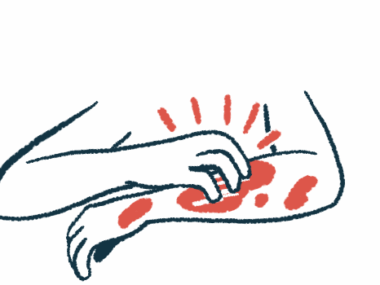Givlaari found safe, effective for up to 4 years in AIP patients: Study
Long-term use led to reductions in porphyria attacks, need for medications
Written by |

Note: This story was updated Oct. 25, 2024, to correct that hemin was used during this study to treat porphyria attacks.
Long-term use of the approved therapy Givlaari (givosiran) safely led to sustained reductions in porphyria attacks, and in the need for medications to treat such attacks, in people with acute intermittent porphyria (AIP).
That’s according to new data from an open-label extension study that assessed the safety and effectiveness of the treatment’s use for up to four years — the “longest follow-up of patients treated with [Givlaari] reported to date,” according to the researchers.
“These findings are consistent with the long-term efficacy and safety results of the ENVISION trial evaluating [Givlaari] in patients with [acute hepatic porphyria] and recurrent attacks,” the researchers wrote. “Taken together, the long-term clinical trial evidence supports the capacity of [Givlaari] to treat acute disease manifestations in patients with [acute hepatic porphyria].”
Further, the study found that patients were able to significantly reduce their use of attack treatment, or even stop it altogether, when using Givlaari.
The study, “Long-term follow-up of givosiran treatment in patients with acute intermittent porphyria from a phase 1/2, 48-month open-label extension study,” was published in the Orphanet Journal of Rare Diseases.
Researchers report findings of long-term extension study
Porphyria encompasses a group of genetic diseases caused by mutations that disrupt the production of heme, a molecule needed for oxygen transport in the body. As a result, intermediary molecules that would normally be converted into heme, such as aminolevulinic acid, known as ALA, and porphobilinogen, called PBG, instead accumulate to toxic levels, driving disease symptoms.
Acute hepatic porphyrias, or AHPs, comprise a group of four different types of porphyria that are marked by sudden and severe attacks of abdominal pain and alterations in mental status.
Givlaari is an approved therapy for adults with AHP that’s designed to reduce the production of aminolevulinate synthase 1, called ALAS1 — an enzyme that’s overactive in AHP and causes ALA and PBG levels to rise. It contains a small interference RNA that targets and degrades ALAS1 messenger RNA, an intermediary molecule needed for the production of the ALAS1 enzyme. Its use is expected to prevent these intermediary molecules from reaching toxic levels and, consequently, driving porphyria attacks.
Now, a team of researchers from the U.S. and Europe reported the findings of an open-label Phase 1/2 extension study (NCT02949830) that assessed the long-term safety and efficacy of Givlaari among AIP patients. The study involved 16 adults who were given treatment for up to 48 months, or four years. An open-label study is one in which both participants and researchers know the treatment being given.
The participants, who had a median age of 39.5, had completed the last portion of a previous Phase 1 clinical trial (NCT2452372) testing the medication. They then were enrolled in the extension study, in which they received Givlaari once monthly at a dose of 2.5 mg/kg.
These patients had experienced at least two porphyria attacks within the six months preceding the Phase 1 study run-in or were taking hemin to prevent attacks at the start of the run-in.
Among them, 12 individuals (75%) received Givlaari in both the Phase 1 trial and the extension study. The other four were given the placebo during the first trial and then switched to Givlaari in the extension study.
Across all patients, the mean annualized composite attack rate decreased by 97% (from 17 to 0.5) from the run-in period of the initial Phase 1 study to the end of the extension study.
Givlaari found to reduce patients’ need for hemin by 95%
The use of Givlaari also decreased the mean annualized use of hemin, an intravenous, or into-the-vein, treatment sold as Panhematin that’s approved to ease recurrent AIP attacks related to the menstrual cycle in susceptible women. Hemin also can be used to prevent acute porphyria attacks in patients having them frequently.
According to the study, the patients’ use of hemin dropped, from 33.1 days during the run-in period of the Phase 1 trial to 1.2 days at the end of the extension study. That corresponded to a 96% reduction in hemin usage.
“Substantial reductions in hemin use rates were observed with once-monthly [Givlarri],” the researchers wrote, adding that “100% of patients in the [open-label extension] study were free of hemin use at months 33-36 and remained hemin-free for the duration of the study.”
The treatment also reduced median ALA levels by 95% and PBG urine levels by 98%. It also lowered mean urine levels of ALAS1 messenger RNA — the intermediary molecule needed for the production of ALAS1, and Givlaari’s target — by 58%.
In the longest follow-up of [Givlaari]-treated patients reported to date, the therapy maintained an acceptable safety profile and demonstrated sustained improvements in clinical outcomes over 4 years in patients with acute intermittent porphyria.
Quality of life among the patients, as assessed by the EQ-VAS self-rated measure of global health status, increased by a mean of 30% from the start of the Phase 1 study to month 48 of the extension study.
All patients experienced adverse events, the majority of which were mild to moderate in severity. The most frequently reported events included abdominal pain, cold-like symptoms, nausea, fatigue, and injection site reactions.
Seven patients (44%) experienced serious adverse events, which included severe abdominal pain, severe allergic reaction, and deep vein thrombosis — the formation of a blood clot in deep veins, commonly in the legs. One of these events led to treatment discontinuation in one patient.
The same number of patients experienced liver adverse events, particularly an elevation in the levels of liver enzymes. However, all resolved over the course of treatment.
“In the longest follow-up of [Givlaari]-treated patients reported to date, the therapy maintained an acceptable safety profile and demonstrated sustained improvements in clinical outcomes over 4 years in patients with acute intermittent porphyria,” the researchers concluded.







